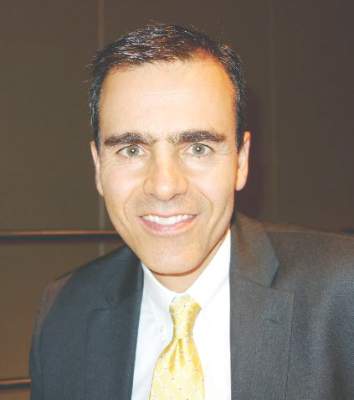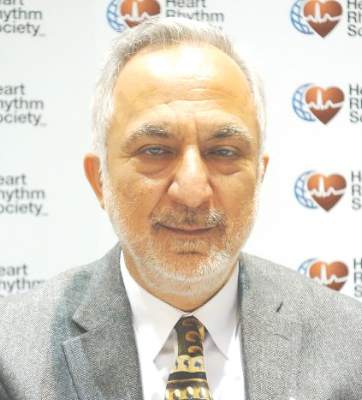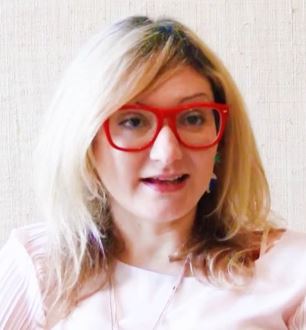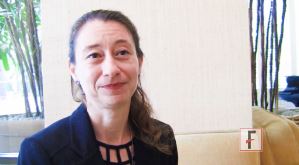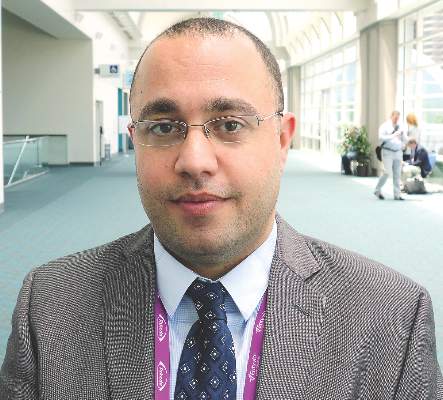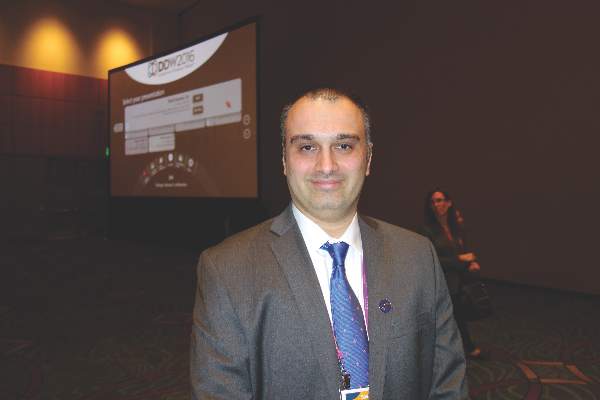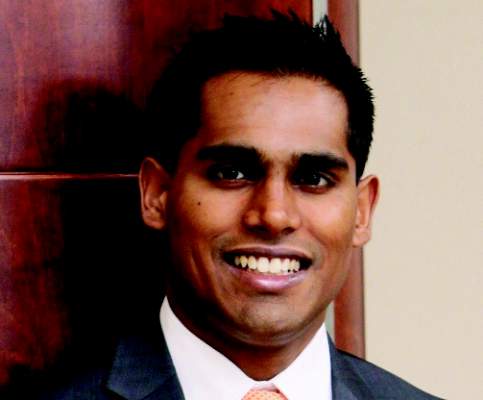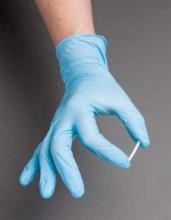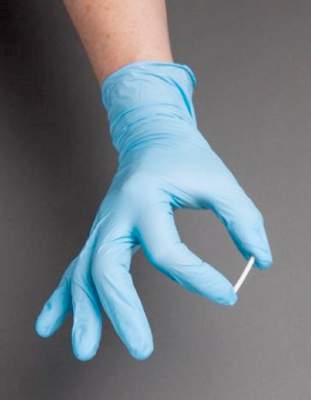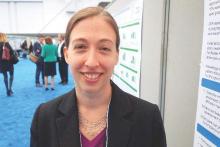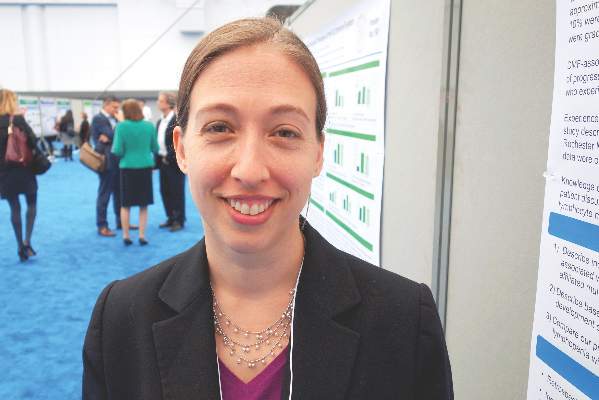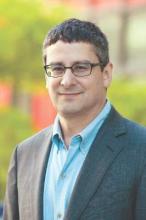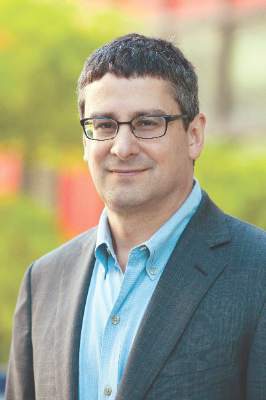User login
M. Alexander Otto began his reporting career early in 1999 covering the pharmaceutical industry for a national pharmacists' magazine and freelancing for the Washington Post and other newspapers. He then joined BNA, now part of Bloomberg News, covering health law and the protection of people and animals in medical research. Alex next worked for the McClatchy Company. Based on his work, Alex won a year-long Knight Science Journalism Fellowship to MIT in 2008-2009. He joined the company shortly thereafter. Alex has a newspaper journalism degree from Syracuse (N.Y.) University and a master's degree in medical science -- a physician assistant degree -- from George Washington University. Alex is based in Seattle.
LAA excision of no benefit in persistent AF ablation
SAN FRANCISCO – Adding left atrial appendage excision to pulmonary vein isolation does not reduce the rate of recurrence in persistent atrial fibrillation, according to a Russian investigation.
Eighty-eight patients with persistent atrial fibrillation (AF) were randomized to thoracoscopic pulmonary vein isolation (PVI) with bilateral epicardial ganglia ablation and box lesion set of the posterior left atrial wall; 88 others were randomized to that approach plus left atrial appendage (LAA) amputation. After 18 months, 64 out of 87 patients in the LAA-excision group (73.6%) and 61 out of 86 patients (70.9%) in the control group were free from recurrent AF, meaning no episodes greater than 30 seconds (P = .73). Freedom from any atrial arrhythmia after a single procedure with or without follow-up antiarrhythmic drugs (AADs) was also similar, with 70.9% in the control and 74.7% in the treatment groups. “Both approaches had excellent” results with no differences in complication rates, but there “was no reduction in AF recurrence when LAA excision was performed,” said investigator Dr. Alexander Romanov of the State Research Institute of Circulation Pathology, Novosibirsk, Russia.
The results are a bit surprising because some previous studies have suggested that electrical isolation of the LAA improves AF ablation success, and surgical excision might be expected to have a similar effect. In many places in the United States, LAA excisions are routine in open heart surgery when patients have AF, to prevent stroke. Guidelines for AF management from the American Heart Association, American College of Cardiology, and Heart Rhythm Society published in 2014 give a class IIb recommendation, saying “surgical excision of the left atrial appendage may be considered in patients undergoing cardiac surgery,” with an evidence level of C, meaning there are no data to support the recommendation, only expert consensus (J Am Coll Cardiol. 2014;64[21]:2246-80).
There were no significant differences between the groups; patients were about 60 years old, on average, and more than 80% in both groups had baseline CHADS2 scores of 0 or 1. All patients had persistent AF for more than a week but no longer than a year; longer-standing cases were excluded, as were patients with prior heart surgeries or catheter ablations. There were no statistically significant differences in operative times or complications. A few patients in each arm needed sternotomies for hemostasis, and one in each arm had a stroke during follow-up. Patients were followed at regular intervals by ECG and Holter monitoring.
AADs were allowed during the blanking period; patients could continue them afterwards for AF recurrence or have endocardial redo ablations; 10 patients in the control group (12%) and 13 in the LAA group (15%) had repeat procedures (P = .55). Most were for right atrial flutter and a few for left atrial flutter. “Only one redo case was for true AF recurrence,” Dr. Romanov said.
The team did not test for exertion intolerance and other potential LAA excision problems.
Dr. Romanov is a speaker for Medtronic, Biosense Webster, and Boston Scientific.
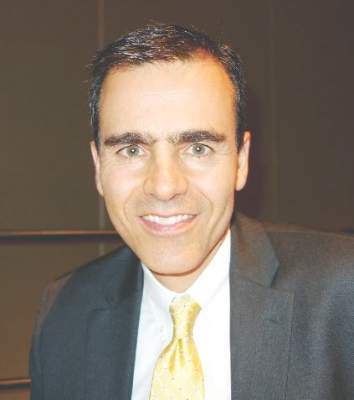 |
Dr. John Day |
This study is interesting because it goes against what other studies are showing, which is that LAA isolation increases the success rate with AF ablation. What makes me a little suspicious is that the success rates in both arms of this study were unusually high for persistent AF. If they were more in line with previous reports, I would feel a little bit better concluding that LAA isolation doesn’t’ help.
I know anecdotally from having done thousands of these ablations that there are some patients whose AF originates from the LAA, and if you treat it, you improve their outcomes.
Dr. John Day is the director of Intermountain Heart Rhythm Specialists in Murray, Utah, and the current president of the Hearth Rhythm Society. He has no disclosures.
 |
Dr. John Day |
This study is interesting because it goes against what other studies are showing, which is that LAA isolation increases the success rate with AF ablation. What makes me a little suspicious is that the success rates in both arms of this study were unusually high for persistent AF. If they were more in line with previous reports, I would feel a little bit better concluding that LAA isolation doesn’t’ help.
I know anecdotally from having done thousands of these ablations that there are some patients whose AF originates from the LAA, and if you treat it, you improve their outcomes.
Dr. John Day is the director of Intermountain Heart Rhythm Specialists in Murray, Utah, and the current president of the Hearth Rhythm Society. He has no disclosures.
 |
Dr. John Day |
This study is interesting because it goes against what other studies are showing, which is that LAA isolation increases the success rate with AF ablation. What makes me a little suspicious is that the success rates in both arms of this study were unusually high for persistent AF. If they were more in line with previous reports, I would feel a little bit better concluding that LAA isolation doesn’t’ help.
I know anecdotally from having done thousands of these ablations that there are some patients whose AF originates from the LAA, and if you treat it, you improve their outcomes.
Dr. John Day is the director of Intermountain Heart Rhythm Specialists in Murray, Utah, and the current president of the Hearth Rhythm Society. He has no disclosures.
SAN FRANCISCO – Adding left atrial appendage excision to pulmonary vein isolation does not reduce the rate of recurrence in persistent atrial fibrillation, according to a Russian investigation.
Eighty-eight patients with persistent atrial fibrillation (AF) were randomized to thoracoscopic pulmonary vein isolation (PVI) with bilateral epicardial ganglia ablation and box lesion set of the posterior left atrial wall; 88 others were randomized to that approach plus left atrial appendage (LAA) amputation. After 18 months, 64 out of 87 patients in the LAA-excision group (73.6%) and 61 out of 86 patients (70.9%) in the control group were free from recurrent AF, meaning no episodes greater than 30 seconds (P = .73). Freedom from any atrial arrhythmia after a single procedure with or without follow-up antiarrhythmic drugs (AADs) was also similar, with 70.9% in the control and 74.7% in the treatment groups. “Both approaches had excellent” results with no differences in complication rates, but there “was no reduction in AF recurrence when LAA excision was performed,” said investigator Dr. Alexander Romanov of the State Research Institute of Circulation Pathology, Novosibirsk, Russia.
The results are a bit surprising because some previous studies have suggested that electrical isolation of the LAA improves AF ablation success, and surgical excision might be expected to have a similar effect. In many places in the United States, LAA excisions are routine in open heart surgery when patients have AF, to prevent stroke. Guidelines for AF management from the American Heart Association, American College of Cardiology, and Heart Rhythm Society published in 2014 give a class IIb recommendation, saying “surgical excision of the left atrial appendage may be considered in patients undergoing cardiac surgery,” with an evidence level of C, meaning there are no data to support the recommendation, only expert consensus (J Am Coll Cardiol. 2014;64[21]:2246-80).
There were no significant differences between the groups; patients were about 60 years old, on average, and more than 80% in both groups had baseline CHADS2 scores of 0 or 1. All patients had persistent AF for more than a week but no longer than a year; longer-standing cases were excluded, as were patients with prior heart surgeries or catheter ablations. There were no statistically significant differences in operative times or complications. A few patients in each arm needed sternotomies for hemostasis, and one in each arm had a stroke during follow-up. Patients were followed at regular intervals by ECG and Holter monitoring.
AADs were allowed during the blanking period; patients could continue them afterwards for AF recurrence or have endocardial redo ablations; 10 patients in the control group (12%) and 13 in the LAA group (15%) had repeat procedures (P = .55). Most were for right atrial flutter and a few for left atrial flutter. “Only one redo case was for true AF recurrence,” Dr. Romanov said.
The team did not test for exertion intolerance and other potential LAA excision problems.
Dr. Romanov is a speaker for Medtronic, Biosense Webster, and Boston Scientific.
SAN FRANCISCO – Adding left atrial appendage excision to pulmonary vein isolation does not reduce the rate of recurrence in persistent atrial fibrillation, according to a Russian investigation.
Eighty-eight patients with persistent atrial fibrillation (AF) were randomized to thoracoscopic pulmonary vein isolation (PVI) with bilateral epicardial ganglia ablation and box lesion set of the posterior left atrial wall; 88 others were randomized to that approach plus left atrial appendage (LAA) amputation. After 18 months, 64 out of 87 patients in the LAA-excision group (73.6%) and 61 out of 86 patients (70.9%) in the control group were free from recurrent AF, meaning no episodes greater than 30 seconds (P = .73). Freedom from any atrial arrhythmia after a single procedure with or without follow-up antiarrhythmic drugs (AADs) was also similar, with 70.9% in the control and 74.7% in the treatment groups. “Both approaches had excellent” results with no differences in complication rates, but there “was no reduction in AF recurrence when LAA excision was performed,” said investigator Dr. Alexander Romanov of the State Research Institute of Circulation Pathology, Novosibirsk, Russia.
The results are a bit surprising because some previous studies have suggested that electrical isolation of the LAA improves AF ablation success, and surgical excision might be expected to have a similar effect. In many places in the United States, LAA excisions are routine in open heart surgery when patients have AF, to prevent stroke. Guidelines for AF management from the American Heart Association, American College of Cardiology, and Heart Rhythm Society published in 2014 give a class IIb recommendation, saying “surgical excision of the left atrial appendage may be considered in patients undergoing cardiac surgery,” with an evidence level of C, meaning there are no data to support the recommendation, only expert consensus (J Am Coll Cardiol. 2014;64[21]:2246-80).
There were no significant differences between the groups; patients were about 60 years old, on average, and more than 80% in both groups had baseline CHADS2 scores of 0 or 1. All patients had persistent AF for more than a week but no longer than a year; longer-standing cases were excluded, as were patients with prior heart surgeries or catheter ablations. There were no statistically significant differences in operative times or complications. A few patients in each arm needed sternotomies for hemostasis, and one in each arm had a stroke during follow-up. Patients were followed at regular intervals by ECG and Holter monitoring.
AADs were allowed during the blanking period; patients could continue them afterwards for AF recurrence or have endocardial redo ablations; 10 patients in the control group (12%) and 13 in the LAA group (15%) had repeat procedures (P = .55). Most were for right atrial flutter and a few for left atrial flutter. “Only one redo case was for true AF recurrence,” Dr. Romanov said.
The team did not test for exertion intolerance and other potential LAA excision problems.
Dr. Romanov is a speaker for Medtronic, Biosense Webster, and Boston Scientific.
AT HEART RHYTHM 2016
Key clinical point: Adding left atrial appendage excision to pulmonary vein isolation does not reduce the rate of recurrence in persistent atrial fibrillation.
Major finding: After 18 months, 64 out of 87 patients in the LAA-excision group (73.6%) and 61 out of 86 patients (70.9%) in the control group were free from recurrent AF, meaning no episodes greater than 30 seconds (P = 0.73).
Data source: Randomized trial in 176 patients with persistent AF.
Disclosures: The lead investigator is a speaker for Medtronic, Biosense Webster, and Boston Scientific.
ICD same-day discharge safe, but not a money saver
San Francisco – Same day discharge is generally safe after cardioverter defibrillator implantation for primary prevention, but it doesn’t save money.
Furthermore, guidelines are needed to standardize the practice as it becomes increasingly common in the United States, according to a 25-site investigation.
After implantable cardioverter defibrillator (ICD) procedures, patients were monitored for 3-4 hours, and their devices were checked for proper functioning; 129 patients who were stable at that point were randomized to early discharge and 136 to next day discharge (NDD).
The overall 30-day procedural complication rate was 3.1% in the same day discharge (SDD) group and 1.6% in the NDD group, a nonsignificant difference (P = .37). Three patients in the SDD group developed hematomas that resolved on their own, and one had a cardiac perforation. One NDD patient dislodged a lead and another developed an infection. There were no differences in quality of life measures between the two groups at 30 days.
However, there were also no differences in procedural and perioperative direct costs, which was surprising because saving money is a major driver of SDD, and the most expensive part of ICD implantation is the first 24 hours. Direct per-patient medical costs in the study – estimated by applying hospital cost-to-charge ratios to the Medicare-reported charge – were $31,771 for SDD and $30,437 for NDD, but NDD was more expensive than SDD at several sites. The investigators suspect a flaw in their analysis related to the opaque nature of hospital accounting, and plan to look into the matter further with modeling to identify savings opportunities with SDD.
“We can insert ICDs on an outpatient basis, but this study will be difficult to replicate because clinical practice is moving towards SDD. In view of this, we think professional societies should be thinking of standardizing criteria for SDD; guidelines would help with the adoption of this approach. There are clinicians who are astute and have great clinical judgment, but there are others who need a scoring system. We believe that by using the 270,000 patients in the [American College of Cardiology’s ICD Registry], there is the ability to identify patients who have low periprocedural risk,” said lead investigator Dr. Ranjit Suri, a cardiologist at Mt. Sinai Hospital in New York.
The study excluded patients receiving an ICD for secondary prevention, as well as those on periprocedural heparin and patients who were pacemaker dependent. SDD seemed safe otherwise, but it’s unknown “if our concept of low risk is acceptable to all implanting physicians,” Dr. Suri said at the annual scientific sessions of the Heart Rhythm Society.
The study groups were well matched. About 75% in each arm were men, and ischemic cardiomyopathy was the leading ICD indication. Patients were amenable to the idea of SDD; the advent of remote monitoring “adds a certain sense of safety” for both patients and physicians, he said.
Dr. Suri is a speaker for Boehringer Ingelheim and St. Jude Medical. He is also a consultant for Biosense Webster and Zoll, and receives research funding from St. Jude.
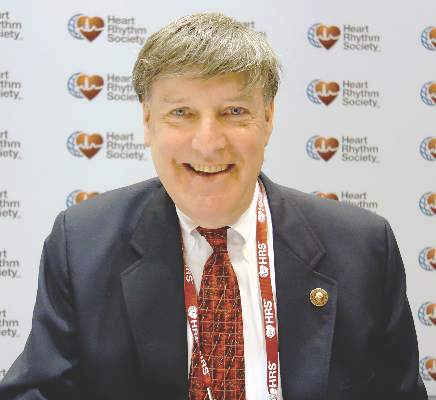 |
Dr. Thomas Deering |
The vast majority of primary prevention patients who are clinically stable enough to come in as outpatients can go home as outpatients if you watch them for a short period of time and make sure they are clinically stable. Most patients don’t want to be in the hospital, and many hospitals are crunched for available beds. It would be great to have guidelines on how to handle this, but we have to allow for clinical judgment.
Dr. Thomas Deering is chief of the Arrhythmia Center at the Piedmont Heart Institute in Atlanta, where he is also chairman of the Executive Council and the Clinical Centers for Excellence. He moderated Dr. Suri’s presentation and was not involved in the work.
 |
Dr. Thomas Deering |
The vast majority of primary prevention patients who are clinically stable enough to come in as outpatients can go home as outpatients if you watch them for a short period of time and make sure they are clinically stable. Most patients don’t want to be in the hospital, and many hospitals are crunched for available beds. It would be great to have guidelines on how to handle this, but we have to allow for clinical judgment.
Dr. Thomas Deering is chief of the Arrhythmia Center at the Piedmont Heart Institute in Atlanta, where he is also chairman of the Executive Council and the Clinical Centers for Excellence. He moderated Dr. Suri’s presentation and was not involved in the work.
 |
Dr. Thomas Deering |
The vast majority of primary prevention patients who are clinically stable enough to come in as outpatients can go home as outpatients if you watch them for a short period of time and make sure they are clinically stable. Most patients don’t want to be in the hospital, and many hospitals are crunched for available beds. It would be great to have guidelines on how to handle this, but we have to allow for clinical judgment.
Dr. Thomas Deering is chief of the Arrhythmia Center at the Piedmont Heart Institute in Atlanta, where he is also chairman of the Executive Council and the Clinical Centers for Excellence. He moderated Dr. Suri’s presentation and was not involved in the work.
San Francisco – Same day discharge is generally safe after cardioverter defibrillator implantation for primary prevention, but it doesn’t save money.
Furthermore, guidelines are needed to standardize the practice as it becomes increasingly common in the United States, according to a 25-site investigation.
After implantable cardioverter defibrillator (ICD) procedures, patients were monitored for 3-4 hours, and their devices were checked for proper functioning; 129 patients who were stable at that point were randomized to early discharge and 136 to next day discharge (NDD).
The overall 30-day procedural complication rate was 3.1% in the same day discharge (SDD) group and 1.6% in the NDD group, a nonsignificant difference (P = .37). Three patients in the SDD group developed hematomas that resolved on their own, and one had a cardiac perforation. One NDD patient dislodged a lead and another developed an infection. There were no differences in quality of life measures between the two groups at 30 days.
However, there were also no differences in procedural and perioperative direct costs, which was surprising because saving money is a major driver of SDD, and the most expensive part of ICD implantation is the first 24 hours. Direct per-patient medical costs in the study – estimated by applying hospital cost-to-charge ratios to the Medicare-reported charge – were $31,771 for SDD and $30,437 for NDD, but NDD was more expensive than SDD at several sites. The investigators suspect a flaw in their analysis related to the opaque nature of hospital accounting, and plan to look into the matter further with modeling to identify savings opportunities with SDD.
“We can insert ICDs on an outpatient basis, but this study will be difficult to replicate because clinical practice is moving towards SDD. In view of this, we think professional societies should be thinking of standardizing criteria for SDD; guidelines would help with the adoption of this approach. There are clinicians who are astute and have great clinical judgment, but there are others who need a scoring system. We believe that by using the 270,000 patients in the [American College of Cardiology’s ICD Registry], there is the ability to identify patients who have low periprocedural risk,” said lead investigator Dr. Ranjit Suri, a cardiologist at Mt. Sinai Hospital in New York.
The study excluded patients receiving an ICD for secondary prevention, as well as those on periprocedural heparin and patients who were pacemaker dependent. SDD seemed safe otherwise, but it’s unknown “if our concept of low risk is acceptable to all implanting physicians,” Dr. Suri said at the annual scientific sessions of the Heart Rhythm Society.
The study groups were well matched. About 75% in each arm were men, and ischemic cardiomyopathy was the leading ICD indication. Patients were amenable to the idea of SDD; the advent of remote monitoring “adds a certain sense of safety” for both patients and physicians, he said.
Dr. Suri is a speaker for Boehringer Ingelheim and St. Jude Medical. He is also a consultant for Biosense Webster and Zoll, and receives research funding from St. Jude.
San Francisco – Same day discharge is generally safe after cardioverter defibrillator implantation for primary prevention, but it doesn’t save money.
Furthermore, guidelines are needed to standardize the practice as it becomes increasingly common in the United States, according to a 25-site investigation.
After implantable cardioverter defibrillator (ICD) procedures, patients were monitored for 3-4 hours, and their devices were checked for proper functioning; 129 patients who were stable at that point were randomized to early discharge and 136 to next day discharge (NDD).
The overall 30-day procedural complication rate was 3.1% in the same day discharge (SDD) group and 1.6% in the NDD group, a nonsignificant difference (P = .37). Three patients in the SDD group developed hematomas that resolved on their own, and one had a cardiac perforation. One NDD patient dislodged a lead and another developed an infection. There were no differences in quality of life measures between the two groups at 30 days.
However, there were also no differences in procedural and perioperative direct costs, which was surprising because saving money is a major driver of SDD, and the most expensive part of ICD implantation is the first 24 hours. Direct per-patient medical costs in the study – estimated by applying hospital cost-to-charge ratios to the Medicare-reported charge – were $31,771 for SDD and $30,437 for NDD, but NDD was more expensive than SDD at several sites. The investigators suspect a flaw in their analysis related to the opaque nature of hospital accounting, and plan to look into the matter further with modeling to identify savings opportunities with SDD.
“We can insert ICDs on an outpatient basis, but this study will be difficult to replicate because clinical practice is moving towards SDD. In view of this, we think professional societies should be thinking of standardizing criteria for SDD; guidelines would help with the adoption of this approach. There are clinicians who are astute and have great clinical judgment, but there are others who need a scoring system. We believe that by using the 270,000 patients in the [American College of Cardiology’s ICD Registry], there is the ability to identify patients who have low periprocedural risk,” said lead investigator Dr. Ranjit Suri, a cardiologist at Mt. Sinai Hospital in New York.
The study excluded patients receiving an ICD for secondary prevention, as well as those on periprocedural heparin and patients who were pacemaker dependent. SDD seemed safe otherwise, but it’s unknown “if our concept of low risk is acceptable to all implanting physicians,” Dr. Suri said at the annual scientific sessions of the Heart Rhythm Society.
The study groups were well matched. About 75% in each arm were men, and ischemic cardiomyopathy was the leading ICD indication. Patients were amenable to the idea of SDD; the advent of remote monitoring “adds a certain sense of safety” for both patients and physicians, he said.
Dr. Suri is a speaker for Boehringer Ingelheim and St. Jude Medical. He is also a consultant for Biosense Webster and Zoll, and receives research funding from St. Jude.
AT HEART RHYTHM 2016
Key clinical point: Same-day discharge is generally safe after cardioverter defibrillator implantation for primary prevention, but it doesn’t save money and guidelines are needed to standardize the practice as it becomes increasingly common in the United States.
Major finding: The overall 30-day procedural complication rate was 3.1% in the same day discharge (SDD) group and 1.5% in the next-day discharge group, a nonsignificant difference (P = .37).
Data source: Randomized trial of 265 ICD patients.
Disclosures: The lead investigator is a speaker for Boehringer Ingelheim and St. Jude Medical. He is also a consultant for Biosense Webster and Zoll, and receives research funding from St. Jude.
VIDEO: The ins and outs of JAK ihibitors for alopecia
NEWPORT BEACH, CALIF. – The promise of Janus kinase (JAK) inhibitors for alopecia seems to be holding up in the practice of Dr. Natasha Mesinkovska, a dermatologist at the University of California, Irvine.
There’s been much excitement about JAK inhibitors since Yale researchers reported in 2014 that tofacitinib (Xeljanz), a JAK inhibitor approved in the United States for rheumatoid arthritis, appeared to grow a full head of hair, plus body hair, in an essentially hairless 25-year-old man with plaque psoriasis. JAK inhibitors have been under investigation for alopecia ever since. Meanwhile, they are being used off label for hair loss around the country.
In her own practice, Dr. Mesinkovska estimates that about two-thirds of patients have some degree of hair regrowth, with particularly satisfying results in men. About 40 of her alopecia patients have opted for JAK inhibitors so far.
In an interview at the Summit in Aesthetic Medicine, Dr. Mesinkovska shared her insights and tips, as well as promising alopecia results for the psoriasis biologic ustekinumab (Stelara), an interleukin-12 and -23 antagonist. “This is a very exciting time for alopecia areata,” she said.
The Summit in Aesthetic Medicine is held by the Global Academy for Medical Education. Global Academy and this news organization are owned by the same company.
The video associated with this article is no longer available on this site. Please view all of our videos on the MDedge YouTube channel
NEWPORT BEACH, CALIF. – The promise of Janus kinase (JAK) inhibitors for alopecia seems to be holding up in the practice of Dr. Natasha Mesinkovska, a dermatologist at the University of California, Irvine.
There’s been much excitement about JAK inhibitors since Yale researchers reported in 2014 that tofacitinib (Xeljanz), a JAK inhibitor approved in the United States for rheumatoid arthritis, appeared to grow a full head of hair, plus body hair, in an essentially hairless 25-year-old man with plaque psoriasis. JAK inhibitors have been under investigation for alopecia ever since. Meanwhile, they are being used off label for hair loss around the country.
In her own practice, Dr. Mesinkovska estimates that about two-thirds of patients have some degree of hair regrowth, with particularly satisfying results in men. About 40 of her alopecia patients have opted for JAK inhibitors so far.
In an interview at the Summit in Aesthetic Medicine, Dr. Mesinkovska shared her insights and tips, as well as promising alopecia results for the psoriasis biologic ustekinumab (Stelara), an interleukin-12 and -23 antagonist. “This is a very exciting time for alopecia areata,” she said.
The Summit in Aesthetic Medicine is held by the Global Academy for Medical Education. Global Academy and this news organization are owned by the same company.
The video associated with this article is no longer available on this site. Please view all of our videos on the MDedge YouTube channel
NEWPORT BEACH, CALIF. – The promise of Janus kinase (JAK) inhibitors for alopecia seems to be holding up in the practice of Dr. Natasha Mesinkovska, a dermatologist at the University of California, Irvine.
There’s been much excitement about JAK inhibitors since Yale researchers reported in 2014 that tofacitinib (Xeljanz), a JAK inhibitor approved in the United States for rheumatoid arthritis, appeared to grow a full head of hair, plus body hair, in an essentially hairless 25-year-old man with plaque psoriasis. JAK inhibitors have been under investigation for alopecia ever since. Meanwhile, they are being used off label for hair loss around the country.
In her own practice, Dr. Mesinkovska estimates that about two-thirds of patients have some degree of hair regrowth, with particularly satisfying results in men. About 40 of her alopecia patients have opted for JAK inhibitors so far.
In an interview at the Summit in Aesthetic Medicine, Dr. Mesinkovska shared her insights and tips, as well as promising alopecia results for the psoriasis biologic ustekinumab (Stelara), an interleukin-12 and -23 antagonist. “This is a very exciting time for alopecia areata,” she said.
The Summit in Aesthetic Medicine is held by the Global Academy for Medical Education. Global Academy and this news organization are owned by the same company.
The video associated with this article is no longer available on this site. Please view all of our videos on the MDedge YouTube channel
EXPERT ANALYSIS FROM THE SUMMIT IN AESTHETIC MEDICINE
VIDEO: How to treat vascular birthmarks
NEWPORT BEACH, CALIF. – A combination of propranolol and laser is more effective than propranolol alone for infantile hemangiomas, and rapamycin can improve pulse die laser results for port wine stains.
Meanwhile, lasers hurt, so general anesthesia is in order for children as long as they’re older than 6 months.
Those are just a few of the pearls Dr. Kristen Kelly, a University of California, Irvine, professor of dermatology and surgery, shared at the Summit in Aesthetic Medicine. Dr. Kelly explained the latest developments in an interview at the conference, held by Global Academy for Medical Education.
Global Academy and this news organization are owned the same company.
The video associated with this article is no longer available on this site. Please view all of our videos on the MDedge YouTube channel
NEWPORT BEACH, CALIF. – A combination of propranolol and laser is more effective than propranolol alone for infantile hemangiomas, and rapamycin can improve pulse die laser results for port wine stains.
Meanwhile, lasers hurt, so general anesthesia is in order for children as long as they’re older than 6 months.
Those are just a few of the pearls Dr. Kristen Kelly, a University of California, Irvine, professor of dermatology and surgery, shared at the Summit in Aesthetic Medicine. Dr. Kelly explained the latest developments in an interview at the conference, held by Global Academy for Medical Education.
Global Academy and this news organization are owned the same company.
The video associated with this article is no longer available on this site. Please view all of our videos on the MDedge YouTube channel
NEWPORT BEACH, CALIF. – A combination of propranolol and laser is more effective than propranolol alone for infantile hemangiomas, and rapamycin can improve pulse die laser results for port wine stains.
Meanwhile, lasers hurt, so general anesthesia is in order for children as long as they’re older than 6 months.
Those are just a few of the pearls Dr. Kristen Kelly, a University of California, Irvine, professor of dermatology and surgery, shared at the Summit in Aesthetic Medicine. Dr. Kelly explained the latest developments in an interview at the conference, held by Global Academy for Medical Education.
Global Academy and this news organization are owned the same company.
The video associated with this article is no longer available on this site. Please view all of our videos on the MDedge YouTube channel
EXPERT ANALYSIS FROM THE SUMMIT IN AESTHETIC MEDICINE
VIDEO: Endoscopic pyloromyotomy works for gastroparesis when meds don’t
SAN DIEGO – Gastric peroral endoscopic myotomy, a novel procedure for gastroparesis, restored gastric emptying in 30 refractory patients at Johns Hopkins University, Baltimore, and elsewhere in the largest series to date for the technique.
Drug therapy had failed, and Botox injections and transpyloric stenting weren’t helping much. On gastric emptying scans (GES), patients had around 40% of solid meals in their stomachs at 4 hours. Their gastroparesis was related mostly to diabetes and postoperative complications, but about a quarter of the cases were idiopathic.
Twenty-six patients (87%) responded to gastric peroral endoscopic myotomy (G-POEM) during a median follow-up of 5.5 months. Nausea, vomiting, and abdominal pain resolved or improved in most. On repeat GES in 17 patients, emptying time normalized in about half and improved in a third. Overall, patients had 17% of solid meals in their stomachs at 4 hours. G-POEM took an average of 72 minutes, and patients were in the hospital for about 3 days. One patient in the series developed pneumoperitoneum, and another had a prepyloric ulcer.
“The problem with transpyloric stents is that they migrate,” said investigator Dr. Mouen A. Khashab, director of therapeutic endoscopy at Johns Hopkins University. “G-POEM offers a permanent solution with few side effects. You have to be good at doing POEM in the esophagus first, as a prerequisite.”
In an interview at the annual Digestive Disease Week, Dr. Khashab explained the procedure in detail, as well as how he incorporates it into his practice and the patient population most likely to benefit.
SAN DIEGO – Gastric peroral endoscopic myotomy, a novel procedure for gastroparesis, restored gastric emptying in 30 refractory patients at Johns Hopkins University, Baltimore, and elsewhere in the largest series to date for the technique.
Drug therapy had failed, and Botox injections and transpyloric stenting weren’t helping much. On gastric emptying scans (GES), patients had around 40% of solid meals in their stomachs at 4 hours. Their gastroparesis was related mostly to diabetes and postoperative complications, but about a quarter of the cases were idiopathic.
Twenty-six patients (87%) responded to gastric peroral endoscopic myotomy (G-POEM) during a median follow-up of 5.5 months. Nausea, vomiting, and abdominal pain resolved or improved in most. On repeat GES in 17 patients, emptying time normalized in about half and improved in a third. Overall, patients had 17% of solid meals in their stomachs at 4 hours. G-POEM took an average of 72 minutes, and patients were in the hospital for about 3 days. One patient in the series developed pneumoperitoneum, and another had a prepyloric ulcer.
“The problem with transpyloric stents is that they migrate,” said investigator Dr. Mouen A. Khashab, director of therapeutic endoscopy at Johns Hopkins University. “G-POEM offers a permanent solution with few side effects. You have to be good at doing POEM in the esophagus first, as a prerequisite.”
In an interview at the annual Digestive Disease Week, Dr. Khashab explained the procedure in detail, as well as how he incorporates it into his practice and the patient population most likely to benefit.
SAN DIEGO – Gastric peroral endoscopic myotomy, a novel procedure for gastroparesis, restored gastric emptying in 30 refractory patients at Johns Hopkins University, Baltimore, and elsewhere in the largest series to date for the technique.
Drug therapy had failed, and Botox injections and transpyloric stenting weren’t helping much. On gastric emptying scans (GES), patients had around 40% of solid meals in their stomachs at 4 hours. Their gastroparesis was related mostly to diabetes and postoperative complications, but about a quarter of the cases were idiopathic.
Twenty-six patients (87%) responded to gastric peroral endoscopic myotomy (G-POEM) during a median follow-up of 5.5 months. Nausea, vomiting, and abdominal pain resolved or improved in most. On repeat GES in 17 patients, emptying time normalized in about half and improved in a third. Overall, patients had 17% of solid meals in their stomachs at 4 hours. G-POEM took an average of 72 minutes, and patients were in the hospital for about 3 days. One patient in the series developed pneumoperitoneum, and another had a prepyloric ulcer.
“The problem with transpyloric stents is that they migrate,” said investigator Dr. Mouen A. Khashab, director of therapeutic endoscopy at Johns Hopkins University. “G-POEM offers a permanent solution with few side effects. You have to be good at doing POEM in the esophagus first, as a prerequisite.”
In an interview at the annual Digestive Disease Week, Dr. Khashab explained the procedure in detail, as well as how he incorporates it into his practice and the patient population most likely to benefit.
AT DDW® 2016
VIDEO: Accelerated infliximab dosing halved colectomy rate in severe ulcerative colitis
SAN DIEGO – Inpatient infliximab rescue for severe, steroid-refractory ulcerative colitis is more likely to work if patients receive a second infusion 3 days after the first, according to a review of 55 University of Michigan, Ann Arbor, patients.
The traditional approach is one inpatient 5-mg/kg infusion, followed by either colectomy or subsequent outpatient infusions, depending on response. In 2013, physicians at the university began offering a second infusion at 72 hours to patients whose C-reactive protein (CRP) levels did not drop below 0.7 mg/dL after their first infusion, and they also began opting more often for 10-mg/kg dosing.
The review found that 90-day colectomy-free survival was 50% in the 16 accelerated-dosing patients, up from 10.2% in the 36 patients treated with the traditional approach (P less than .001). The finding has led to a new, more aggressive infliximab protocol for inpatient ulcerative colitis.
Among patients who did undergo colectomies, postoperative complications were similar between the two groups. But for reasons that are not clear, 30-day postoperative readmission rates were higher in accelerated patients (58% vs. 25%).
In an interview at the annual Digestive Disease Week, lead investigator Dr. Shail Govani of the University of Michigan explained the thinking behind the new approach, how CRP/albumin ratios come into play, and how to counsel patients in light of the findings.
The video associated with this article is no longer available on this site. Please view all of our videos on the MDedge YouTube channel
SAN DIEGO – Inpatient infliximab rescue for severe, steroid-refractory ulcerative colitis is more likely to work if patients receive a second infusion 3 days after the first, according to a review of 55 University of Michigan, Ann Arbor, patients.
The traditional approach is one inpatient 5-mg/kg infusion, followed by either colectomy or subsequent outpatient infusions, depending on response. In 2013, physicians at the university began offering a second infusion at 72 hours to patients whose C-reactive protein (CRP) levels did not drop below 0.7 mg/dL after their first infusion, and they also began opting more often for 10-mg/kg dosing.
The review found that 90-day colectomy-free survival was 50% in the 16 accelerated-dosing patients, up from 10.2% in the 36 patients treated with the traditional approach (P less than .001). The finding has led to a new, more aggressive infliximab protocol for inpatient ulcerative colitis.
Among patients who did undergo colectomies, postoperative complications were similar between the two groups. But for reasons that are not clear, 30-day postoperative readmission rates were higher in accelerated patients (58% vs. 25%).
In an interview at the annual Digestive Disease Week, lead investigator Dr. Shail Govani of the University of Michigan explained the thinking behind the new approach, how CRP/albumin ratios come into play, and how to counsel patients in light of the findings.
The video associated with this article is no longer available on this site. Please view all of our videos on the MDedge YouTube channel
SAN DIEGO – Inpatient infliximab rescue for severe, steroid-refractory ulcerative colitis is more likely to work if patients receive a second infusion 3 days after the first, according to a review of 55 University of Michigan, Ann Arbor, patients.
The traditional approach is one inpatient 5-mg/kg infusion, followed by either colectomy or subsequent outpatient infusions, depending on response. In 2013, physicians at the university began offering a second infusion at 72 hours to patients whose C-reactive protein (CRP) levels did not drop below 0.7 mg/dL after their first infusion, and they also began opting more often for 10-mg/kg dosing.
The review found that 90-day colectomy-free survival was 50% in the 16 accelerated-dosing patients, up from 10.2% in the 36 patients treated with the traditional approach (P less than .001). The finding has led to a new, more aggressive infliximab protocol for inpatient ulcerative colitis.
Among patients who did undergo colectomies, postoperative complications were similar between the two groups. But for reasons that are not clear, 30-day postoperative readmission rates were higher in accelerated patients (58% vs. 25%).
In an interview at the annual Digestive Disease Week, lead investigator Dr. Shail Govani of the University of Michigan explained the thinking behind the new approach, how CRP/albumin ratios come into play, and how to counsel patients in light of the findings.
The video associated with this article is no longer available on this site. Please view all of our videos on the MDedge YouTube channel
AT DDW 2016
VIDEO: Daily fecal transplants put refractory ulcerative colitis into remission
SAN DIEGO – When fecal transplants don’t work for ulcerative colitis, it’s probably because they aren’t used often enough, according to investigators from the University of New South Wales, Sydney.
The researchers made sure that wasn’t the case in their own double-blind trial, the largest to date of fecal microbiota transplantation (FMT) for ulcerative colitis. Forty-one patients with active, mild to moderate disease (Mayo score 4-10) that was resistant to standard medications were randomized to 150-mL, self-administered fecal enemas 5 days a week for 8 weeks, and 40 others to placebo enemas. Patients were tapered off steroids at study entrance, and each FMT patient received stool from 3-7 unrelated donors.
Steroid-free clinical remission and endoscopic remission or response were achieved in 11 FMT patients (27%), compared with 3 (8%) placebo patients (P = .02). A total of 18 treated patients (44%) and 8 placebo patients (20%) had steroid-free clinical remissions, while 22 treated patients (54%) and 9 patients in the placebo group (23%) had some type of positive clinical response (P less than .01).
Patients were in their mid-30s, on average, with disease durations of about 6 years. More than half were men. About one-quarter were on oral steroids, and more than half were on oral 5-aminosalicylic acid medications, which were allowed during the study. Almost half were on methotrexate or other oral immunomodulators, which were also allowed. Patients were excluded if they had been on a biologic in the previous 12 weeks.
Afterward, 37 patients in the placebo arm opted for open-label FMT. Results were similar, with steroid-free clinical remission and endoscopic remission or response in 10 patients (27%), clinical remission in 17 (46%), and endoscopic remission in 9 (24%).
The anatomical extent of disease did not affect outcome, but patients with more severe endoscopic disease and those on steroids at study entrance didn’t do as well. Three patients flared during the trial, one in the placebo arm and two in the FMT arm, one of whom required colectomy.
The investigators were surprised by the magnitude of the benefit, given the mixed results in previous investigations with less frequent dosing. But they were not surprised that FMT worked.
“In ulcerative colitis, the microbiota appear to be the antigenic driver, so it makes sense that correcting the disturbance” helps, said lead investigator Dr. Sudarshan Paramsothy, a gastroenterologist at the University of New South Wales.
Dr. Paramsothy and his colleagues have a hunch they can do even better. They are looking into the microbiologic factors of donors and patients that influence response, with the ultimate goal of matching the best donor to the best patient. They’re examining maintenance therapy, too; “it’s one thing to induce remission, it’s another thing to maintain remission,” Dr. Paramsothy said.
In an interview at the annual Digestive Disease Week, he explained the technique, the thinking behind it, future directions, and how to counsel patients in light of the findings.
The video associated with this article is no longer available on this site. Please view all of our videos on the MDedge YouTube channel
SAN DIEGO – When fecal transplants don’t work for ulcerative colitis, it’s probably because they aren’t used often enough, according to investigators from the University of New South Wales, Sydney.
The researchers made sure that wasn’t the case in their own double-blind trial, the largest to date of fecal microbiota transplantation (FMT) for ulcerative colitis. Forty-one patients with active, mild to moderate disease (Mayo score 4-10) that was resistant to standard medications were randomized to 150-mL, self-administered fecal enemas 5 days a week for 8 weeks, and 40 others to placebo enemas. Patients were tapered off steroids at study entrance, and each FMT patient received stool from 3-7 unrelated donors.
Steroid-free clinical remission and endoscopic remission or response were achieved in 11 FMT patients (27%), compared with 3 (8%) placebo patients (P = .02). A total of 18 treated patients (44%) and 8 placebo patients (20%) had steroid-free clinical remissions, while 22 treated patients (54%) and 9 patients in the placebo group (23%) had some type of positive clinical response (P less than .01).
Patients were in their mid-30s, on average, with disease durations of about 6 years. More than half were men. About one-quarter were on oral steroids, and more than half were on oral 5-aminosalicylic acid medications, which were allowed during the study. Almost half were on methotrexate or other oral immunomodulators, which were also allowed. Patients were excluded if they had been on a biologic in the previous 12 weeks.
Afterward, 37 patients in the placebo arm opted for open-label FMT. Results were similar, with steroid-free clinical remission and endoscopic remission or response in 10 patients (27%), clinical remission in 17 (46%), and endoscopic remission in 9 (24%).
The anatomical extent of disease did not affect outcome, but patients with more severe endoscopic disease and those on steroids at study entrance didn’t do as well. Three patients flared during the trial, one in the placebo arm and two in the FMT arm, one of whom required colectomy.
The investigators were surprised by the magnitude of the benefit, given the mixed results in previous investigations with less frequent dosing. But they were not surprised that FMT worked.
“In ulcerative colitis, the microbiota appear to be the antigenic driver, so it makes sense that correcting the disturbance” helps, said lead investigator Dr. Sudarshan Paramsothy, a gastroenterologist at the University of New South Wales.
Dr. Paramsothy and his colleagues have a hunch they can do even better. They are looking into the microbiologic factors of donors and patients that influence response, with the ultimate goal of matching the best donor to the best patient. They’re examining maintenance therapy, too; “it’s one thing to induce remission, it’s another thing to maintain remission,” Dr. Paramsothy said.
In an interview at the annual Digestive Disease Week, he explained the technique, the thinking behind it, future directions, and how to counsel patients in light of the findings.
The video associated with this article is no longer available on this site. Please view all of our videos on the MDedge YouTube channel
SAN DIEGO – When fecal transplants don’t work for ulcerative colitis, it’s probably because they aren’t used often enough, according to investigators from the University of New South Wales, Sydney.
The researchers made sure that wasn’t the case in their own double-blind trial, the largest to date of fecal microbiota transplantation (FMT) for ulcerative colitis. Forty-one patients with active, mild to moderate disease (Mayo score 4-10) that was resistant to standard medications were randomized to 150-mL, self-administered fecal enemas 5 days a week for 8 weeks, and 40 others to placebo enemas. Patients were tapered off steroids at study entrance, and each FMT patient received stool from 3-7 unrelated donors.
Steroid-free clinical remission and endoscopic remission or response were achieved in 11 FMT patients (27%), compared with 3 (8%) placebo patients (P = .02). A total of 18 treated patients (44%) and 8 placebo patients (20%) had steroid-free clinical remissions, while 22 treated patients (54%) and 9 patients in the placebo group (23%) had some type of positive clinical response (P less than .01).
Patients were in their mid-30s, on average, with disease durations of about 6 years. More than half were men. About one-quarter were on oral steroids, and more than half were on oral 5-aminosalicylic acid medications, which were allowed during the study. Almost half were on methotrexate or other oral immunomodulators, which were also allowed. Patients were excluded if they had been on a biologic in the previous 12 weeks.
Afterward, 37 patients in the placebo arm opted for open-label FMT. Results were similar, with steroid-free clinical remission and endoscopic remission or response in 10 patients (27%), clinical remission in 17 (46%), and endoscopic remission in 9 (24%).
The anatomical extent of disease did not affect outcome, but patients with more severe endoscopic disease and those on steroids at study entrance didn’t do as well. Three patients flared during the trial, one in the placebo arm and two in the FMT arm, one of whom required colectomy.
The investigators were surprised by the magnitude of the benefit, given the mixed results in previous investigations with less frequent dosing. But they were not surprised that FMT worked.
“In ulcerative colitis, the microbiota appear to be the antigenic driver, so it makes sense that correcting the disturbance” helps, said lead investigator Dr. Sudarshan Paramsothy, a gastroenterologist at the University of New South Wales.
Dr. Paramsothy and his colleagues have a hunch they can do even better. They are looking into the microbiologic factors of donors and patients that influence response, with the ultimate goal of matching the best donor to the best patient. They’re examining maintenance therapy, too; “it’s one thing to induce remission, it’s another thing to maintain remission,” Dr. Paramsothy said.
In an interview at the annual Digestive Disease Week, he explained the technique, the thinking behind it, future directions, and how to counsel patients in light of the findings.
The video associated with this article is no longer available on this site. Please view all of our videos on the MDedge YouTube channel
AT DDW 2016
Probuphine implant predicted to ease buprenorphine maintenance
Probuphine, a subdermal buprenorphine implant approved May 26 by the Food and Drug administration for opioid addiction, will likely increase adherence to buprenorphine maintenance, therapy by making it more convenient, according to Caleb Banta-Green, Ph.D., a senior researcher at the University of Washington Alcohol and Drug Abuse Institute in Seattle.
Buprenorphine is a partial opioid agonist that blocks the effects of full agonists and dulls withdrawal symptoms. “It’s a very effective drug treatment medication. It can cut mortality in half” compared to abstinence-only programs, and “in general, the longer people are on it, the better. [Probuphine will] make long-term therapy much” easier for patients and physicians, he said.
Probuphine consists of four 1-inch rods implanted subdermally inside the upper arm. The product delivers buprenorphine continuously for up to 6 months, and is approved as an alternative to daily dosing in patients stable on 8 mg or less of oral buprenorphine, a low-to-moderate dose.
“My sense is it will be used in stable patients who want the convenience, but I think we’ll also see it used in people who have trouble adhering to everyday dosing, or who miss doses and relapse. Once it’s out there, I think you’ll start seeing people use it in different ways,” said Dr. Peter Friedmann, an addiction treatment specialist in Springfield, Mass., and chief research officer for Baystate Health.
In a 6-month trial, the implant worked as well as daily sublingual dosing; urine screens remained clean in 63% of Probuphine patients versus 64% of sublingual patients, although a few patients in the Probuphine arm required sublingual supplementation. The FDA rejected an indication for buprenorphine induction.
Labeling allows for two back-to-back courses for a total treatment duration of 1 year, but the FDA has required the distributer, Braeburn Pharmaceuticals, to study longer treatment courses.
Prescribing requires a buprenorphine waiver, as well as live training on implant insertion and removal, which is part of the product’s Risk Evaluation and Mitigation Strategy program. Probuphine also comes with a medication guide for patients.
Labeling notes that the implant “should be used as part of a complete treatment program to include counseling and psychosocial support.” The FDA recommends an office visit 1 week after implantation then follow-up visits no longer than 1 month apart.
There should be less of a diversion risk with Probuphine, which might make buprenorphine prescribing more attractive for physicians, but uptake will depend in part on Probuphine’s price and insurers’ willingness to cover it. Braeburn plans a product launch this summer, but hasn’t released pricing information.
“We assume it’s going to be expensive,” Dr. Banta-Green said.
Labeling warns of the risk of nerve damage with the implant and removal procedure, as well as implant migration, protrusion, and expulsion. The most common side effects in trials were implant-site pain, itching, and redness, as well as systemic side effects in line with other buprenorphine formulations, including headache, insomnia, upper respiratory tract infection, nausea, anxiety, back pain, depression, constipation, and vomiting.
There is abuse potential. Each rod contains 80 mg of buprenorphine, so patients will leave the office with 320 mg in their arm. “If they really want to take (the rods) out and extract the medication, people will do that. Our street chemists are very ingenious,” Dr. Friedmann said.
Dr. Banta-Green has no disclosures. Dr. Friedmann is an adviser for Indivior, maker of Suboxone, and disclosed research funding from Alkermes.
Probuphine, a subdermal buprenorphine implant approved May 26 by the Food and Drug administration for opioid addiction, will likely increase adherence to buprenorphine maintenance, therapy by making it more convenient, according to Caleb Banta-Green, Ph.D., a senior researcher at the University of Washington Alcohol and Drug Abuse Institute in Seattle.
Buprenorphine is a partial opioid agonist that blocks the effects of full agonists and dulls withdrawal symptoms. “It’s a very effective drug treatment medication. It can cut mortality in half” compared to abstinence-only programs, and “in general, the longer people are on it, the better. [Probuphine will] make long-term therapy much” easier for patients and physicians, he said.
Probuphine consists of four 1-inch rods implanted subdermally inside the upper arm. The product delivers buprenorphine continuously for up to 6 months, and is approved as an alternative to daily dosing in patients stable on 8 mg or less of oral buprenorphine, a low-to-moderate dose.
“My sense is it will be used in stable patients who want the convenience, but I think we’ll also see it used in people who have trouble adhering to everyday dosing, or who miss doses and relapse. Once it’s out there, I think you’ll start seeing people use it in different ways,” said Dr. Peter Friedmann, an addiction treatment specialist in Springfield, Mass., and chief research officer for Baystate Health.
In a 6-month trial, the implant worked as well as daily sublingual dosing; urine screens remained clean in 63% of Probuphine patients versus 64% of sublingual patients, although a few patients in the Probuphine arm required sublingual supplementation. The FDA rejected an indication for buprenorphine induction.
Labeling allows for two back-to-back courses for a total treatment duration of 1 year, but the FDA has required the distributer, Braeburn Pharmaceuticals, to study longer treatment courses.
Prescribing requires a buprenorphine waiver, as well as live training on implant insertion and removal, which is part of the product’s Risk Evaluation and Mitigation Strategy program. Probuphine also comes with a medication guide for patients.
Labeling notes that the implant “should be used as part of a complete treatment program to include counseling and psychosocial support.” The FDA recommends an office visit 1 week after implantation then follow-up visits no longer than 1 month apart.
There should be less of a diversion risk with Probuphine, which might make buprenorphine prescribing more attractive for physicians, but uptake will depend in part on Probuphine’s price and insurers’ willingness to cover it. Braeburn plans a product launch this summer, but hasn’t released pricing information.
“We assume it’s going to be expensive,” Dr. Banta-Green said.
Labeling warns of the risk of nerve damage with the implant and removal procedure, as well as implant migration, protrusion, and expulsion. The most common side effects in trials were implant-site pain, itching, and redness, as well as systemic side effects in line with other buprenorphine formulations, including headache, insomnia, upper respiratory tract infection, nausea, anxiety, back pain, depression, constipation, and vomiting.
There is abuse potential. Each rod contains 80 mg of buprenorphine, so patients will leave the office with 320 mg in their arm. “If they really want to take (the rods) out and extract the medication, people will do that. Our street chemists are very ingenious,” Dr. Friedmann said.
Dr. Banta-Green has no disclosures. Dr. Friedmann is an adviser for Indivior, maker of Suboxone, and disclosed research funding from Alkermes.
Probuphine, a subdermal buprenorphine implant approved May 26 by the Food and Drug administration for opioid addiction, will likely increase adherence to buprenorphine maintenance, therapy by making it more convenient, according to Caleb Banta-Green, Ph.D., a senior researcher at the University of Washington Alcohol and Drug Abuse Institute in Seattle.
Buprenorphine is a partial opioid agonist that blocks the effects of full agonists and dulls withdrawal symptoms. “It’s a very effective drug treatment medication. It can cut mortality in half” compared to abstinence-only programs, and “in general, the longer people are on it, the better. [Probuphine will] make long-term therapy much” easier for patients and physicians, he said.
Probuphine consists of four 1-inch rods implanted subdermally inside the upper arm. The product delivers buprenorphine continuously for up to 6 months, and is approved as an alternative to daily dosing in patients stable on 8 mg or less of oral buprenorphine, a low-to-moderate dose.
“My sense is it will be used in stable patients who want the convenience, but I think we’ll also see it used in people who have trouble adhering to everyday dosing, or who miss doses and relapse. Once it’s out there, I think you’ll start seeing people use it in different ways,” said Dr. Peter Friedmann, an addiction treatment specialist in Springfield, Mass., and chief research officer for Baystate Health.
In a 6-month trial, the implant worked as well as daily sublingual dosing; urine screens remained clean in 63% of Probuphine patients versus 64% of sublingual patients, although a few patients in the Probuphine arm required sublingual supplementation. The FDA rejected an indication for buprenorphine induction.
Labeling allows for two back-to-back courses for a total treatment duration of 1 year, but the FDA has required the distributer, Braeburn Pharmaceuticals, to study longer treatment courses.
Prescribing requires a buprenorphine waiver, as well as live training on implant insertion and removal, which is part of the product’s Risk Evaluation and Mitigation Strategy program. Probuphine also comes with a medication guide for patients.
Labeling notes that the implant “should be used as part of a complete treatment program to include counseling and psychosocial support.” The FDA recommends an office visit 1 week after implantation then follow-up visits no longer than 1 month apart.
There should be less of a diversion risk with Probuphine, which might make buprenorphine prescribing more attractive for physicians, but uptake will depend in part on Probuphine’s price and insurers’ willingness to cover it. Braeburn plans a product launch this summer, but hasn’t released pricing information.
“We assume it’s going to be expensive,” Dr. Banta-Green said.
Labeling warns of the risk of nerve damage with the implant and removal procedure, as well as implant migration, protrusion, and expulsion. The most common side effects in trials were implant-site pain, itching, and redness, as well as systemic side effects in line with other buprenorphine formulations, including headache, insomnia, upper respiratory tract infection, nausea, anxiety, back pain, depression, constipation, and vomiting.
There is abuse potential. Each rod contains 80 mg of buprenorphine, so patients will leave the office with 320 mg in their arm. “If they really want to take (the rods) out and extract the medication, people will do that. Our street chemists are very ingenious,” Dr. Friedmann said.
Dr. Banta-Green has no disclosures. Dr. Friedmann is an adviser for Indivior, maker of Suboxone, and disclosed research funding from Alkermes.
Age, lower baseline ALC increase dimethyl fumarate lymphopenia risk
VANCOUVER – The risk of dimethyl fumarate lymphopenia – and perhaps progressive multifocal leukoencephalopathy – is greatest in patients 60 years or older and those with baseline absolute lymphocyte counts below 2 x 109/L, according to a review of 206 patients with relapsing-remitting or progressive multiple sclerosis from the University of Rochester (N.Y.).
A total of 87 patients (42%), all of whom were on dimethyl fumarate (DMF; Tecfidera) for at least 3 months, developed lymphopenia with an absolute lymphocyte count (ALC) below 0.91 x 109/L. That’s not a surprise; lymphopenia is a well-known side effect of the drug, and the rates in Rochester were similar to what was reported in clinical trials. The greatest concern with DMF lymphopenia is subsequent progressive multifocal leukoencephalopathy (PML); a handful of cases have been reported in lymphopenic patients, none in the University of Rochester review.
What was surprising was that in the 34 patients aged 60 years or older, 24 (71%) developed lymphopenia, versus 62 (36%) of the 172 under 60 years old (P = .0005). Meanwhile, of 93 patients with baseline ALCs below 2 x 109/L, 49 (53%) became lymphopenic, versus 34 of 104 patients (33%) who started DMF with higher lymphocyte counts (P = .0006). A total of nine patients in the study did not have a baseline ALC available.
“If I had a patient who was 70 years old with a low baseline lymphocyte count, [these findings] would weigh into my decisions about choosing” this medication. “Age and baseline ALC may guide future selection of patients for DMF therapy,” neurologist and investigator Dr. Jessica Robb said at the annual meeting of the American Academy of Neurology.
Also, because higher grade lymphopenia didn’t resolve in most cases until the drug was stopped, “if I had a patient who developed more severe grade 3 or 4 lymphopenia, I would probably have a lower threshold for” discontinuation. “I would probably think about changing medication more quickly rather than leaving them on [DMF] and hoping that their lymphopenia resolves,” Dr. Robb said.
The Rochester findings are in line with a 2015 report from Washington University, St. Louis, that also indicated a higher risk of moderate to severe lymphopenia in older patients and those with lower baseline ALCs, as well as recent natalizumab (Tysabri) users. Grade 2 or worse lymphopenia “is unlikely to resolve while on the drug,” the St. Louis investigators concluded (Mult Scler J Exp Transl Clin. 2015 Jan-Dec;1:2055217315596994).
Taken together, the two studies are important because there’s otherwise not much else in the medical literature identifying DMF lymphopenia risk factors. Lymphopenia and PML are also concerns with other multiple sclerosis (MS) agents.
“The increased prevalence of lymphopenia in older patients and in patients with a lower baseline ALC suggests a failure of lymphopoiesis triggered by DMF therapy. Indeed, lymphopoiesis declines with age due to thymic involution and decreased production of naive lymphocytes. ... Whether these consequences of normal aging could be amplified by DMF is an avenue for future study,” the St. Louis team said.
“The significance of increased risk for lymphopenia in patients recently exposed to natalizumab is not immediately obvious. ... Natalizumab is known to expand circulating leukocytes, including progenitor cells. If in turn, DMF causes lymphocyte apoptosis or arrest of differentiation, then patients sequentially exposed to natalizumab and DMF might have a larger number of circulating lymphocytes vulnerable to DMF effects than other patients,” they said.
Food and Drug Administration labeling for DMF recommends lymphocyte counts at baseline, 6 months, and every 6-12 months thereafter. However, European regulators recently recommended lymphocyte counts at baseline and every 3 months to catch problems early, as well as baseline MRIs as references for possible PML.
Standard, 240-mg twice-daily dosing was used at the University of Rochester, and the mean age in the study was 49 years. The majority of patients were women, and the mean duration of MS was 11 years. Almost three-quarters of the patients were new to immunosuppression, and none of the patients developed serious infections.
The University of Rochester team noted a higher rate of grade 1 lymphopenia than reported in clinical trials (18% vs. 10%). Twelve patients (6%) discontinued DMF because of lymphopenia.
Dr. Robb and the other investigators had no relevant disclosures.
VANCOUVER – The risk of dimethyl fumarate lymphopenia – and perhaps progressive multifocal leukoencephalopathy – is greatest in patients 60 years or older and those with baseline absolute lymphocyte counts below 2 x 109/L, according to a review of 206 patients with relapsing-remitting or progressive multiple sclerosis from the University of Rochester (N.Y.).
A total of 87 patients (42%), all of whom were on dimethyl fumarate (DMF; Tecfidera) for at least 3 months, developed lymphopenia with an absolute lymphocyte count (ALC) below 0.91 x 109/L. That’s not a surprise; lymphopenia is a well-known side effect of the drug, and the rates in Rochester were similar to what was reported in clinical trials. The greatest concern with DMF lymphopenia is subsequent progressive multifocal leukoencephalopathy (PML); a handful of cases have been reported in lymphopenic patients, none in the University of Rochester review.
What was surprising was that in the 34 patients aged 60 years or older, 24 (71%) developed lymphopenia, versus 62 (36%) of the 172 under 60 years old (P = .0005). Meanwhile, of 93 patients with baseline ALCs below 2 x 109/L, 49 (53%) became lymphopenic, versus 34 of 104 patients (33%) who started DMF with higher lymphocyte counts (P = .0006). A total of nine patients in the study did not have a baseline ALC available.
“If I had a patient who was 70 years old with a low baseline lymphocyte count, [these findings] would weigh into my decisions about choosing” this medication. “Age and baseline ALC may guide future selection of patients for DMF therapy,” neurologist and investigator Dr. Jessica Robb said at the annual meeting of the American Academy of Neurology.
Also, because higher grade lymphopenia didn’t resolve in most cases until the drug was stopped, “if I had a patient who developed more severe grade 3 or 4 lymphopenia, I would probably have a lower threshold for” discontinuation. “I would probably think about changing medication more quickly rather than leaving them on [DMF] and hoping that their lymphopenia resolves,” Dr. Robb said.
The Rochester findings are in line with a 2015 report from Washington University, St. Louis, that also indicated a higher risk of moderate to severe lymphopenia in older patients and those with lower baseline ALCs, as well as recent natalizumab (Tysabri) users. Grade 2 or worse lymphopenia “is unlikely to resolve while on the drug,” the St. Louis investigators concluded (Mult Scler J Exp Transl Clin. 2015 Jan-Dec;1:2055217315596994).
Taken together, the two studies are important because there’s otherwise not much else in the medical literature identifying DMF lymphopenia risk factors. Lymphopenia and PML are also concerns with other multiple sclerosis (MS) agents.
“The increased prevalence of lymphopenia in older patients and in patients with a lower baseline ALC suggests a failure of lymphopoiesis triggered by DMF therapy. Indeed, lymphopoiesis declines with age due to thymic involution and decreased production of naive lymphocytes. ... Whether these consequences of normal aging could be amplified by DMF is an avenue for future study,” the St. Louis team said.
“The significance of increased risk for lymphopenia in patients recently exposed to natalizumab is not immediately obvious. ... Natalizumab is known to expand circulating leukocytes, including progenitor cells. If in turn, DMF causes lymphocyte apoptosis or arrest of differentiation, then patients sequentially exposed to natalizumab and DMF might have a larger number of circulating lymphocytes vulnerable to DMF effects than other patients,” they said.
Food and Drug Administration labeling for DMF recommends lymphocyte counts at baseline, 6 months, and every 6-12 months thereafter. However, European regulators recently recommended lymphocyte counts at baseline and every 3 months to catch problems early, as well as baseline MRIs as references for possible PML.
Standard, 240-mg twice-daily dosing was used at the University of Rochester, and the mean age in the study was 49 years. The majority of patients were women, and the mean duration of MS was 11 years. Almost three-quarters of the patients were new to immunosuppression, and none of the patients developed serious infections.
The University of Rochester team noted a higher rate of grade 1 lymphopenia than reported in clinical trials (18% vs. 10%). Twelve patients (6%) discontinued DMF because of lymphopenia.
Dr. Robb and the other investigators had no relevant disclosures.
VANCOUVER – The risk of dimethyl fumarate lymphopenia – and perhaps progressive multifocal leukoencephalopathy – is greatest in patients 60 years or older and those with baseline absolute lymphocyte counts below 2 x 109/L, according to a review of 206 patients with relapsing-remitting or progressive multiple sclerosis from the University of Rochester (N.Y.).
A total of 87 patients (42%), all of whom were on dimethyl fumarate (DMF; Tecfidera) for at least 3 months, developed lymphopenia with an absolute lymphocyte count (ALC) below 0.91 x 109/L. That’s not a surprise; lymphopenia is a well-known side effect of the drug, and the rates in Rochester were similar to what was reported in clinical trials. The greatest concern with DMF lymphopenia is subsequent progressive multifocal leukoencephalopathy (PML); a handful of cases have been reported in lymphopenic patients, none in the University of Rochester review.
What was surprising was that in the 34 patients aged 60 years or older, 24 (71%) developed lymphopenia, versus 62 (36%) of the 172 under 60 years old (P = .0005). Meanwhile, of 93 patients with baseline ALCs below 2 x 109/L, 49 (53%) became lymphopenic, versus 34 of 104 patients (33%) who started DMF with higher lymphocyte counts (P = .0006). A total of nine patients in the study did not have a baseline ALC available.
“If I had a patient who was 70 years old with a low baseline lymphocyte count, [these findings] would weigh into my decisions about choosing” this medication. “Age and baseline ALC may guide future selection of patients for DMF therapy,” neurologist and investigator Dr. Jessica Robb said at the annual meeting of the American Academy of Neurology.
Also, because higher grade lymphopenia didn’t resolve in most cases until the drug was stopped, “if I had a patient who developed more severe grade 3 or 4 lymphopenia, I would probably have a lower threshold for” discontinuation. “I would probably think about changing medication more quickly rather than leaving them on [DMF] and hoping that their lymphopenia resolves,” Dr. Robb said.
The Rochester findings are in line with a 2015 report from Washington University, St. Louis, that also indicated a higher risk of moderate to severe lymphopenia in older patients and those with lower baseline ALCs, as well as recent natalizumab (Tysabri) users. Grade 2 or worse lymphopenia “is unlikely to resolve while on the drug,” the St. Louis investigators concluded (Mult Scler J Exp Transl Clin. 2015 Jan-Dec;1:2055217315596994).
Taken together, the two studies are important because there’s otherwise not much else in the medical literature identifying DMF lymphopenia risk factors. Lymphopenia and PML are also concerns with other multiple sclerosis (MS) agents.
“The increased prevalence of lymphopenia in older patients and in patients with a lower baseline ALC suggests a failure of lymphopoiesis triggered by DMF therapy. Indeed, lymphopoiesis declines with age due to thymic involution and decreased production of naive lymphocytes. ... Whether these consequences of normal aging could be amplified by DMF is an avenue for future study,” the St. Louis team said.
“The significance of increased risk for lymphopenia in patients recently exposed to natalizumab is not immediately obvious. ... Natalizumab is known to expand circulating leukocytes, including progenitor cells. If in turn, DMF causes lymphocyte apoptosis or arrest of differentiation, then patients sequentially exposed to natalizumab and DMF might have a larger number of circulating lymphocytes vulnerable to DMF effects than other patients,” they said.
Food and Drug Administration labeling for DMF recommends lymphocyte counts at baseline, 6 months, and every 6-12 months thereafter. However, European regulators recently recommended lymphocyte counts at baseline and every 3 months to catch problems early, as well as baseline MRIs as references for possible PML.
Standard, 240-mg twice-daily dosing was used at the University of Rochester, and the mean age in the study was 49 years. The majority of patients were women, and the mean duration of MS was 11 years. Almost three-quarters of the patients were new to immunosuppression, and none of the patients developed serious infections.
The University of Rochester team noted a higher rate of grade 1 lymphopenia than reported in clinical trials (18% vs. 10%). Twelve patients (6%) discontinued DMF because of lymphopenia.
Dr. Robb and the other investigators had no relevant disclosures.
AT THE AAN 2016 ANNUAL MEETING
Key clinical point: Dimethyl fumarate is probably not the best option for older patients with lower baseline lymphocyte counts.
Major finding: Among 34 patients aged 60 years or older, 24 (71%) developed lymphopenia, versus 62 (36%) of the 172 under 60 years old (P = .0005). Meanwhile, of 93 patients with baseline ALCs below 2 x 109/L, 49 (53%) became lymphopenic, versus 34 of 104 patients (33%) who started DMF with higher lymphocyte counts (P = .0006).
Data source: Review of 206 patients with relapsing-remitting or progressive multiple sclerosis
Disclosures: The investigators had no disclosures.
Ocrelizumab bests interferon for relapsing MS at 2 years
VANCOUVER – Ocrelizumab, a B-cell depleting humanized monoclonal antibody being developed by Hoffman–La Roche, consistently outperformed interferon beta-1a (Rebif) for relapsing multiple sclerosis in two phase III trials reported at the annual meeting of the American Academy of Neurology.
The identical trials, dubbed OPERA I and OPERA II, each had about 800 patients. Subjects were randomized one-to-one to intravenous ocrelizumab 600 mg every 24 weeks or to subcutaneous interferon beta-1a 44 micrograms three times weekly over 96 weeks. Patients had early disease; a significant portion were naive to multiple sclerosis (MS) treatments.
At 96 weeks, 47.9% and 47.5% of ocrelizumab patients versus 29.2% and 25.1% of interferon patients had no evidence of disease activity (NEDA) in the two studies. NEDA is a composite score defined as no relapses, no confirmed disability progression, and no new or enlarging T2 or gadolinium-enhancing T1 lesions.
Across both studies, relapses occurred in about 20% of ocrelizumab patients versus about 35% of interferon patients. About 10% of ocrelizumab, but about 15% of interferon patients, had clinical disease progression. Similarly, about 10% of ocrelizumab patients developed new gadolinium-enhancing lesions, compared with about 35% in the interferon groups. New or enlarging T2 lesions were found in about 40% in the ocrelizumab groups but in more than 60% in the interferon arms.
After week 24, 96% percent of ocrelizumab patients, compared with 60%-70% on interferon, were free of new or enlarging T2 lesions.
In short, ocrelizumab “resulted in greater achievement of NEDA versus [interferon] over 96 weeks, with elimination of new/enlarging T2 lesions in nearly all patients after week 24,” the researchers concluded.
“These are very impressive numbers,” especially because ocrelizumab was compared with a standard treatment. “There was a wonderful constancy of results” across the trials; “a very highly effective treatment is emerging for multiple sclerosis,” said investigator and presenter Dr. Anthony Traboulsee, a neurologist at the University of British Columbia, Vancouver, who also noted that in many cases, patients opted to stay on ocrelizumab at the end of the trials.
Dr. Traboulsee did not present safety data. A previous report of 24-week results found that infusion reactions were significantly more common with ocrelizumab than with interferon beta-1a (34% vs. 9.7%). Otherwise, there were similar rates of serious adverse events, including serious infections, and there were no cases of progressive multifocal leukoencephalopathy (PML). The PML and infection findings are especially important; Roche shelved earlier attempts to develop the biologic for lupus and rheumatoid arthritis due to serious and opportunistic infections, some of which were fatal.
Roche plans to submit its approval package to the Food and Drug Administration in the first half of 2016; the tentative brand name is Ocrevus. FDA granted the biologic breakthrough, fast-track status for primary progressive MS based on the strength of an earlier phase III trial. At present, there are no MS agents indicated for primary progressive disease.
Patients in OPERA were 37 years old, on average, and two-thirds were women. The mean baseline score on the Extended Disability Status Scale was 2.77, and the mean time since diagnosis was about 4 years. Patients had about 1.5 relapses in the first and second year before entering the studies.
The positive results – and the increasing buzz about ocrelizumab in the MS community – raise the question of how it will fit into the MS armamentarium if it’s approved, which seems likely. A review in Therapeutic Advances in Neurological Disorders tackled the issue in January, before the OPERA results were made public (2016 Jan; 9[1]:44-52).
It’s unclear if ocrelizumab will become the go-to option when patients progress on first-line agents such as interferon and glatiramer acetate. Phase II data suggest ocrelizumab’s “effect on clinical disease activity [seems] to be of the same magnitude compared with that of fingolimod and natalizumab,” and will likely be an alternative to natalizumab and alemtuzumab. “Ocrelizumab seems to have a more favourable risk–benefit profile compared with natalizumab in JC [John Cunningham] virus antibody–positive patients, whereas natalizumab in JC virus antibody–negative patients appears safer. Hence, ocrelizumab could be an attractive option among second-line therapies in patients who are JC virus antibody positive, whereas natalizumab or alternatively oral fingolimod would be the first choice among second-line therapies in JC virus antibody–negative patients,” said authors Dr. Per Soelberg Sorensen and Dr. Morten Blinkenberg, both MS neurologists at the University of Copenhagen.
“It needs to be emphasized that long-term data on the safety of ocrelizumab in the treatment of MS is warranted, and therefore post-marketing safety programs will be needed.” The risk of PML with long-term use is unknown. “Another unsolved question is whether ocrelizumab therapy should be applied at fixed intervals, e.g. every 6 months [as in OPERA], or if re-treatment should be guided by the recovery of CD19-positive B cells,” they said.
In any case, infusion reactions with ocrelizumab should be less than with rituximab (Rituxan), another B-cell depleter used off-label for MS, because ocrelizumab is a more humanized antibody.
OPERA 1 and 2 were funded by Hoffmann–La Roche. Dr. Traboulsee is a paid speaker, consultant, and researcher for the company. Other investigators also reported various ties to Roche; several are employees. The review authors had no disclosures.
VANCOUVER – Ocrelizumab, a B-cell depleting humanized monoclonal antibody being developed by Hoffman–La Roche, consistently outperformed interferon beta-1a (Rebif) for relapsing multiple sclerosis in two phase III trials reported at the annual meeting of the American Academy of Neurology.
The identical trials, dubbed OPERA I and OPERA II, each had about 800 patients. Subjects were randomized one-to-one to intravenous ocrelizumab 600 mg every 24 weeks or to subcutaneous interferon beta-1a 44 micrograms three times weekly over 96 weeks. Patients had early disease; a significant portion were naive to multiple sclerosis (MS) treatments.
At 96 weeks, 47.9% and 47.5% of ocrelizumab patients versus 29.2% and 25.1% of interferon patients had no evidence of disease activity (NEDA) in the two studies. NEDA is a composite score defined as no relapses, no confirmed disability progression, and no new or enlarging T2 or gadolinium-enhancing T1 lesions.
Across both studies, relapses occurred in about 20% of ocrelizumab patients versus about 35% of interferon patients. About 10% of ocrelizumab, but about 15% of interferon patients, had clinical disease progression. Similarly, about 10% of ocrelizumab patients developed new gadolinium-enhancing lesions, compared with about 35% in the interferon groups. New or enlarging T2 lesions were found in about 40% in the ocrelizumab groups but in more than 60% in the interferon arms.
After week 24, 96% percent of ocrelizumab patients, compared with 60%-70% on interferon, were free of new or enlarging T2 lesions.
In short, ocrelizumab “resulted in greater achievement of NEDA versus [interferon] over 96 weeks, with elimination of new/enlarging T2 lesions in nearly all patients after week 24,” the researchers concluded.
“These are very impressive numbers,” especially because ocrelizumab was compared with a standard treatment. “There was a wonderful constancy of results” across the trials; “a very highly effective treatment is emerging for multiple sclerosis,” said investigator and presenter Dr. Anthony Traboulsee, a neurologist at the University of British Columbia, Vancouver, who also noted that in many cases, patients opted to stay on ocrelizumab at the end of the trials.
Dr. Traboulsee did not present safety data. A previous report of 24-week results found that infusion reactions were significantly more common with ocrelizumab than with interferon beta-1a (34% vs. 9.7%). Otherwise, there were similar rates of serious adverse events, including serious infections, and there were no cases of progressive multifocal leukoencephalopathy (PML). The PML and infection findings are especially important; Roche shelved earlier attempts to develop the biologic for lupus and rheumatoid arthritis due to serious and opportunistic infections, some of which were fatal.
Roche plans to submit its approval package to the Food and Drug Administration in the first half of 2016; the tentative brand name is Ocrevus. FDA granted the biologic breakthrough, fast-track status for primary progressive MS based on the strength of an earlier phase III trial. At present, there are no MS agents indicated for primary progressive disease.
Patients in OPERA were 37 years old, on average, and two-thirds were women. The mean baseline score on the Extended Disability Status Scale was 2.77, and the mean time since diagnosis was about 4 years. Patients had about 1.5 relapses in the first and second year before entering the studies.
The positive results – and the increasing buzz about ocrelizumab in the MS community – raise the question of how it will fit into the MS armamentarium if it’s approved, which seems likely. A review in Therapeutic Advances in Neurological Disorders tackled the issue in January, before the OPERA results were made public (2016 Jan; 9[1]:44-52).
It’s unclear if ocrelizumab will become the go-to option when patients progress on first-line agents such as interferon and glatiramer acetate. Phase II data suggest ocrelizumab’s “effect on clinical disease activity [seems] to be of the same magnitude compared with that of fingolimod and natalizumab,” and will likely be an alternative to natalizumab and alemtuzumab. “Ocrelizumab seems to have a more favourable risk–benefit profile compared with natalizumab in JC [John Cunningham] virus antibody–positive patients, whereas natalizumab in JC virus antibody–negative patients appears safer. Hence, ocrelizumab could be an attractive option among second-line therapies in patients who are JC virus antibody positive, whereas natalizumab or alternatively oral fingolimod would be the first choice among second-line therapies in JC virus antibody–negative patients,” said authors Dr. Per Soelberg Sorensen and Dr. Morten Blinkenberg, both MS neurologists at the University of Copenhagen.
“It needs to be emphasized that long-term data on the safety of ocrelizumab in the treatment of MS is warranted, and therefore post-marketing safety programs will be needed.” The risk of PML with long-term use is unknown. “Another unsolved question is whether ocrelizumab therapy should be applied at fixed intervals, e.g. every 6 months [as in OPERA], or if re-treatment should be guided by the recovery of CD19-positive B cells,” they said.
In any case, infusion reactions with ocrelizumab should be less than with rituximab (Rituxan), another B-cell depleter used off-label for MS, because ocrelizumab is a more humanized antibody.
OPERA 1 and 2 were funded by Hoffmann–La Roche. Dr. Traboulsee is a paid speaker, consultant, and researcher for the company. Other investigators also reported various ties to Roche; several are employees. The review authors had no disclosures.
VANCOUVER – Ocrelizumab, a B-cell depleting humanized monoclonal antibody being developed by Hoffman–La Roche, consistently outperformed interferon beta-1a (Rebif) for relapsing multiple sclerosis in two phase III trials reported at the annual meeting of the American Academy of Neurology.
The identical trials, dubbed OPERA I and OPERA II, each had about 800 patients. Subjects were randomized one-to-one to intravenous ocrelizumab 600 mg every 24 weeks or to subcutaneous interferon beta-1a 44 micrograms three times weekly over 96 weeks. Patients had early disease; a significant portion were naive to multiple sclerosis (MS) treatments.
At 96 weeks, 47.9% and 47.5% of ocrelizumab patients versus 29.2% and 25.1% of interferon patients had no evidence of disease activity (NEDA) in the two studies. NEDA is a composite score defined as no relapses, no confirmed disability progression, and no new or enlarging T2 or gadolinium-enhancing T1 lesions.
Across both studies, relapses occurred in about 20% of ocrelizumab patients versus about 35% of interferon patients. About 10% of ocrelizumab, but about 15% of interferon patients, had clinical disease progression. Similarly, about 10% of ocrelizumab patients developed new gadolinium-enhancing lesions, compared with about 35% in the interferon groups. New or enlarging T2 lesions were found in about 40% in the ocrelizumab groups but in more than 60% in the interferon arms.
After week 24, 96% percent of ocrelizumab patients, compared with 60%-70% on interferon, were free of new or enlarging T2 lesions.
In short, ocrelizumab “resulted in greater achievement of NEDA versus [interferon] over 96 weeks, with elimination of new/enlarging T2 lesions in nearly all patients after week 24,” the researchers concluded.
“These are very impressive numbers,” especially because ocrelizumab was compared with a standard treatment. “There was a wonderful constancy of results” across the trials; “a very highly effective treatment is emerging for multiple sclerosis,” said investigator and presenter Dr. Anthony Traboulsee, a neurologist at the University of British Columbia, Vancouver, who also noted that in many cases, patients opted to stay on ocrelizumab at the end of the trials.
Dr. Traboulsee did not present safety data. A previous report of 24-week results found that infusion reactions were significantly more common with ocrelizumab than with interferon beta-1a (34% vs. 9.7%). Otherwise, there were similar rates of serious adverse events, including serious infections, and there were no cases of progressive multifocal leukoencephalopathy (PML). The PML and infection findings are especially important; Roche shelved earlier attempts to develop the biologic for lupus and rheumatoid arthritis due to serious and opportunistic infections, some of which were fatal.
Roche plans to submit its approval package to the Food and Drug Administration in the first half of 2016; the tentative brand name is Ocrevus. FDA granted the biologic breakthrough, fast-track status for primary progressive MS based on the strength of an earlier phase III trial. At present, there are no MS agents indicated for primary progressive disease.
Patients in OPERA were 37 years old, on average, and two-thirds were women. The mean baseline score on the Extended Disability Status Scale was 2.77, and the mean time since diagnosis was about 4 years. Patients had about 1.5 relapses in the first and second year before entering the studies.
The positive results – and the increasing buzz about ocrelizumab in the MS community – raise the question of how it will fit into the MS armamentarium if it’s approved, which seems likely. A review in Therapeutic Advances in Neurological Disorders tackled the issue in January, before the OPERA results were made public (2016 Jan; 9[1]:44-52).
It’s unclear if ocrelizumab will become the go-to option when patients progress on first-line agents such as interferon and glatiramer acetate. Phase II data suggest ocrelizumab’s “effect on clinical disease activity [seems] to be of the same magnitude compared with that of fingolimod and natalizumab,” and will likely be an alternative to natalizumab and alemtuzumab. “Ocrelizumab seems to have a more favourable risk–benefit profile compared with natalizumab in JC [John Cunningham] virus antibody–positive patients, whereas natalizumab in JC virus antibody–negative patients appears safer. Hence, ocrelizumab could be an attractive option among second-line therapies in patients who are JC virus antibody positive, whereas natalizumab or alternatively oral fingolimod would be the first choice among second-line therapies in JC virus antibody–negative patients,” said authors Dr. Per Soelberg Sorensen and Dr. Morten Blinkenberg, both MS neurologists at the University of Copenhagen.
“It needs to be emphasized that long-term data on the safety of ocrelizumab in the treatment of MS is warranted, and therefore post-marketing safety programs will be needed.” The risk of PML with long-term use is unknown. “Another unsolved question is whether ocrelizumab therapy should be applied at fixed intervals, e.g. every 6 months [as in OPERA], or if re-treatment should be guided by the recovery of CD19-positive B cells,” they said.
In any case, infusion reactions with ocrelizumab should be less than with rituximab (Rituxan), another B-cell depleter used off-label for MS, because ocrelizumab is a more humanized antibody.
OPERA 1 and 2 were funded by Hoffmann–La Roche. Dr. Traboulsee is a paid speaker, consultant, and researcher for the company. Other investigators also reported various ties to Roche; several are employees. The review authors had no disclosures.
AT THE AAN 2016 ANNUAL MEETING
Key clinical point: Ocrelizumab, a B-cell depleting humanized monoclonal antibody being developed by Hoffman–La Roche, consistently outperformed interferon beta-1a (Rebif) for relapsing multiple sclerosis in two phase III trials reported at the American Academy of Neurology annual meeting.
Major finding: At 96 weeks, 47.9% and 47.5% of ocrelizumab patients versus 29.2% and 25.1% of interferon patients had no evidence of disease activity in the two studies.
Data source: Two phase III trials with about 1,600 relapsing MS patients.
Disclosures: OPERA 1 and 2 were funded by Hoffmann–La Roche. The presenter is a paid speaker, consultant, and researcher for the company. Other investigators also reported various ties to Roche; several are employees.
